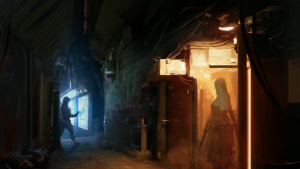We’ve had tremendous interest thus far from fans interested in the upcoming Alternity Playtest, which has exceeded our expectations! We’ll continue collecting email addresses (you can sign up here on our previous blog entry), and we’ll provide more information about the playtest plan in the coming weeks. In the meantime, Rich would like to share some thoughts on player archetypes – take it away, Rich!
In evaluating character creation systems for Alternity, we took a look at the spectrum of skill-based vs class-based character progressions. In a skill-based system, most of your interaction with the game rules lives on your character sheet in the form of your skill scores. Over time as your character gains experience, you improve your character’s skills by spending skill points (or a similar currency) to improve the skills you desire. So to get better at shooting a blaster rifle, you might spend skill points in a Ranged Weapons (rifles) skill, for example.
That’s different from the class-based games that might be more familiar to you, where your core competencies are determined by your choice of a character class. In a game like D&D, if you want to be good at swinging a sword, you choose the fighter class. You’ll get access to fighter-only (or fighter-friendly, anyway) proficiencies, attack bonus, and options that make you good at sword-swinging.
 Class-based systems might lack the flexibility or “simulation value” of skill-based systems in some ways, but they are very good at a couple of things: Providing you with a strong character identity, a job to do in the typical adventuring party, and some hard-wired competencies that other characters might not have. Those are all things that are pretty useful at the gaming table: It’s empowering to feel like you’re the guy in the party who’s special because you can do something no one else can do.
Class-based systems might lack the flexibility or “simulation value” of skill-based systems in some ways, but they are very good at a couple of things: Providing you with a strong character identity, a job to do in the typical adventuring party, and some hard-wired competencies that other characters might not have. Those are all things that are pretty useful at the gaming table: It’s empowering to feel like you’re the guy in the party who’s special because you can do something no one else can do.
One down-side of a true skill-based system is that it can leave characters without a clear role in the group, and can sometimes result in a party of characters who look a lot alike. Or, to put it another way, a skill-based system really has only one character class, and anybody might be good at anything simply by assigning their skills appropriately.
Being game designers, we naturally want to figure out a way to have our cake and eat it too. We’d like the flexibility and elegance of a character defined solely by his or her skills, but then we also want to give that player the tools to carve out his or her special role in the group. Our answer to this particular challenge is to take a little inspiration from the original Alternity game and build a hybrid. The basic chassis is a skill-based game system, but we begin by asking players to choose something like a character class when they create their Alternity hero. We call this the Archetype.
We think of Archetypes as the “narrative role” of your character. If most Alternity characters look like the heroes in a sci-fi action movie, what are the roles you’d like to explore? Do you see your character as a big strong protector? A lethal assassin or gunslinger? An “everyman” with resourcefulness and grit, or perhaps a leader who sees what needs to be done and inspires the rest of the band to pull together? Think of a movie like Guardians of the Galaxy or The Magnificent Seven—you want the players in your typical RPG group to all be awesome in different ways, just like any ensemble cast.
The Archetype doesn’t really affect the way you buy or improve skills (although each Archetype starts off with some bonus skill points in specific skills, making it easier to be good at things we think that Archetype ought to be good at). It doesn’t control the types of weapons and armor you can use or automatically improve your combat skills as you gain experience. Instead, the Archetype’s biggest job is to provide you with access to specific “talent trees,” encouraging you to build a character who is equipped for a particular role in the hero party.
Right now, we’re developing five basic Archetypes: Battler, Expert, Leader, Striker, and Survivor. The Battler and the Striker (for instance) might have the same amount of weapon skills, but the Battler’s Archetype talents provide a little extra durability and the ability to protect allies by drawing enemy fire and keeping enemies focused on him. The Striker, on the other hand, has talents that help her evade enemy fire and pile on extra damage when she catches enemies off-guard.
We think we’ve got a better idea of what Archetypes are *for* than we did when we built the Professions in the original game, and we think our implementation of the Archetype idea is simple and robust . . . but you’ll get to be the judge of that. We’ll elaborate further on the archetypes in future design blogs, and we look forward to seeing if the public playtests bear out our design notions, and learning how we can improve on our initial ideas!



